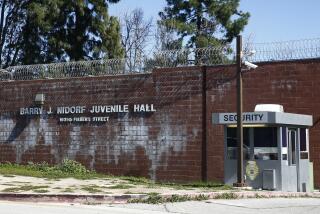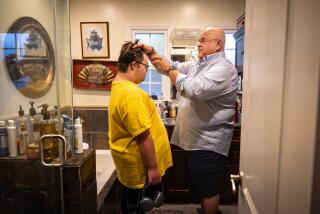A $374 headset? A $153 tape dispenser? DCFS faces fresh criticism over its spending

Philip Browning, the head of the Los Angeles County Department of Children and Family Services, in 2012.
The Department of Children and Family Services, which Los Angeles County auditors have criticized for poor fiscal oversight, now is facing questions about its spending practices — specifically its office equipment purchases.
Among the items acquired in recent months: $374 headsets and a $153 automatic tape dispenser.
Philip Browning, head of the department, said that he has made equipment and technology upgrades a priority following years of neglect. Outfitting case workers with iPhones, dictation technology and ergonomically sound furniture makes them more efficient, he said.
“It’s appropriate to keep employees safe and healthy,” he said. “We spend a huge amount of money on workers’ comp. We need to address that.”
According to department records, the DCFS paid $348,000 in fiscal 2014 for supplies and equipment. That amount more than doubled, to $709,000, in fiscal 2015. And in the first four months of the current fiscal year, the department spent $700,000-plus on the equipment — more than the similarly sized probation department did the last two full years.
A review of invoices by The Times showed that the DCFS bought the wireless office headsets when a comparable, wired alternative was available for $20 — a potential savings of more than $350 each.
Officials said that employees were not required to choose the most cost-effective products to meet their ergonomic needs. And if workers say they need an item to prevent injuries, department policy dictates that they probably will get it, even if the same product has been provided to the same worker before.
No doctor’s note is required, according to department policy.
The variety of products available is vast. One employee requested and received the $153 electric tape dispenser. Another, records show, asked for a $49 doze alert — a device that wakes up someone who has drifted off. Request approved.
“In a time when foster children and foster parents struggle to have their basic needs met, we should be buying solid, cost-effective office equipment — not some of the most expensive stuff on the market,” said Aubrey Manual, president of a foster parent association that has lobbied unsuccessfully for more money to be spent on reversing a critical shortage of foster homes.
“I think it’s appalling that money meant to keep abused and neglected kids safe and improve their lives is instead being wasted on this stuff,” Manual said. “Someone over there needs to use better judgment.”
Germaine Key, of the department’s health and safety management division, said the prices being paid were appropriate. “This seems to be standard for what good products cost,” she said.
This year, the L.A. County auditor-controller criticized other DCFS fiscal practices, blaming poor inventory control for the loss of thousands of dollars in bus tokens meant for clients.
Auditors found that the tokens had been left in open cabinets accessible to anyone in the office, and paper logs didn’t show who had removed them.
The tokens, auditors said, “should be safeguarded in the same manner as cash to prevent theft or misuse.”
According to Browning, ergonomics spending in earlier years might have been artificially low because fewer employees were assigned to interview staffers about what they needed to prevent workplace injuries.
The department also is in the midst of hiring hundreds of new social workers, which could account for some of the increased supply costs, he said.
Join the conversation on Facebook >>
That hiring will increase staff 7% this fiscal year, while the spending on ergonomic equipment could reach 300% if the outlays continue at the current pace. Typically, spending is evenly distributed across all seasons of the year, according to department records.
The DCFS director said that it was important to factor workers’ compensation into any cost-benefit analysis. “This spending can help to avoid claims down the line,” he said.
Workers’ compensation payouts for injures have remained steady at $14 million a year for the last two years.
Twitter: @gtherolf
ALSO
Haskell Wexler, Oscar-winning cinematographer, dies at 93
Suspect arrested in death of Pomona woman who was set ablaze on Christmas Day
Russian sisters’ low profile vanished with the San Bernardino terrorist attack
More to Read
Sign up for Essential California
The most important California stories and recommendations in your inbox every morning.
You may occasionally receive promotional content from the Los Angeles Times.











